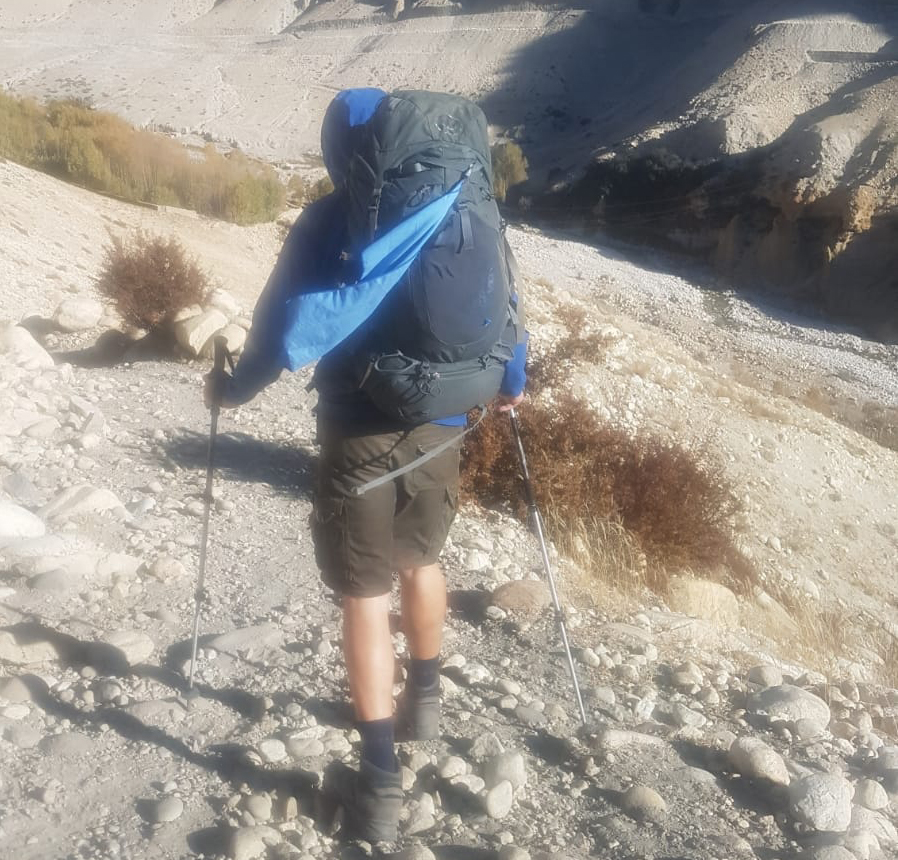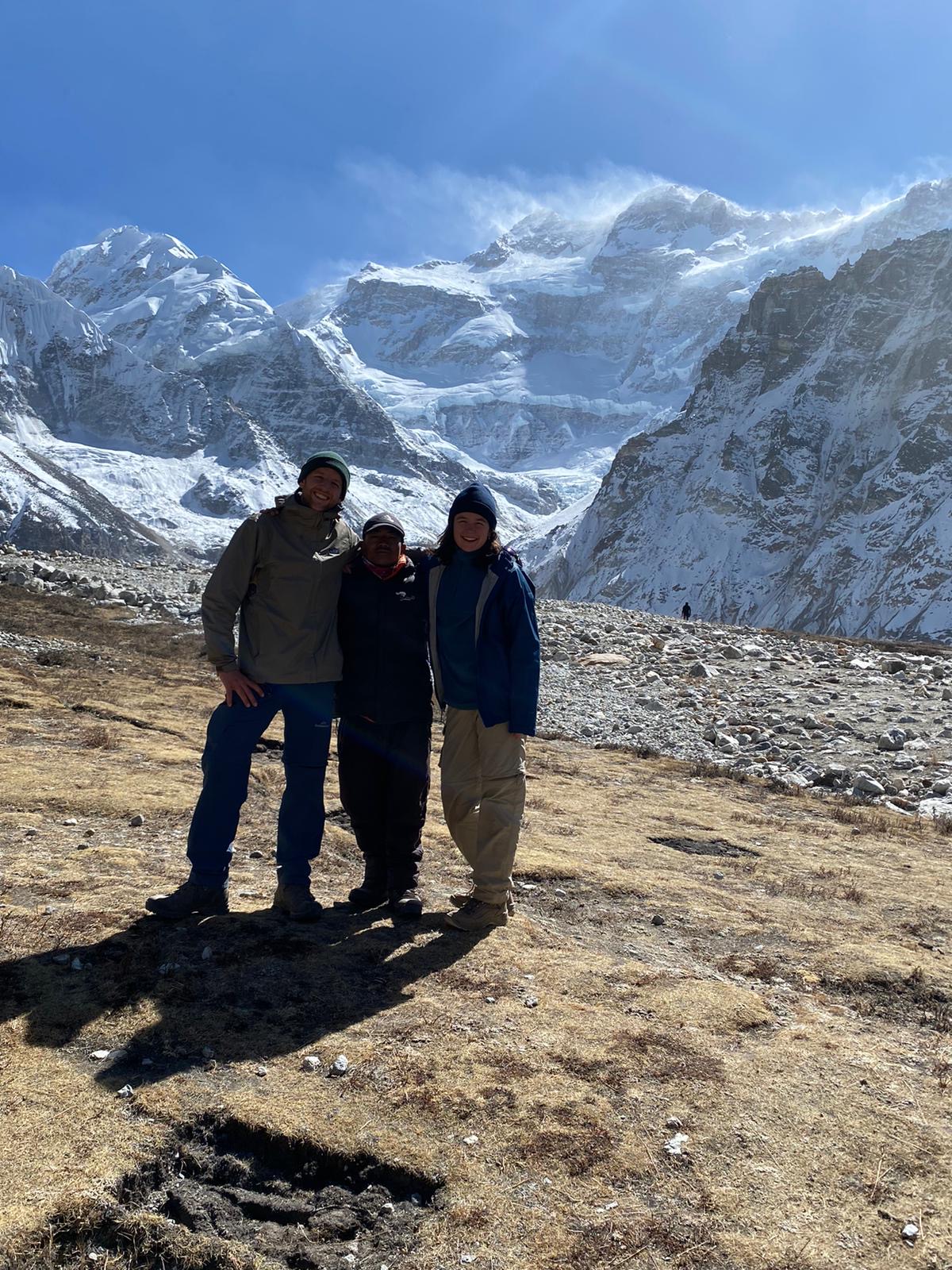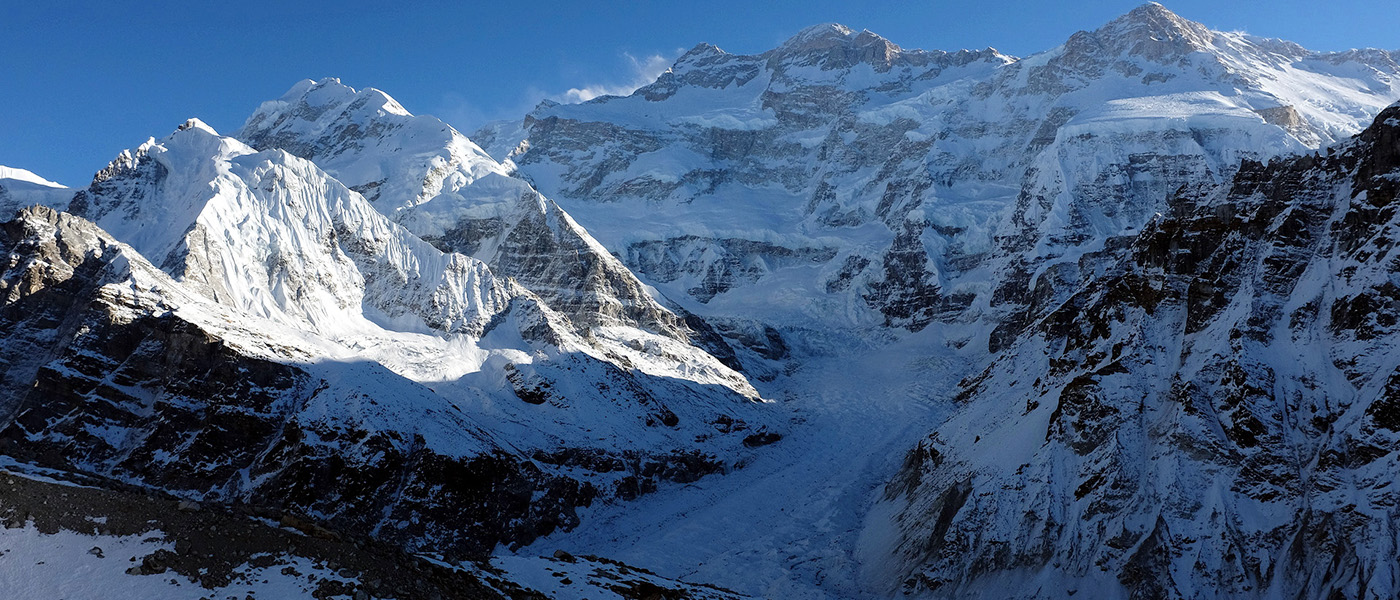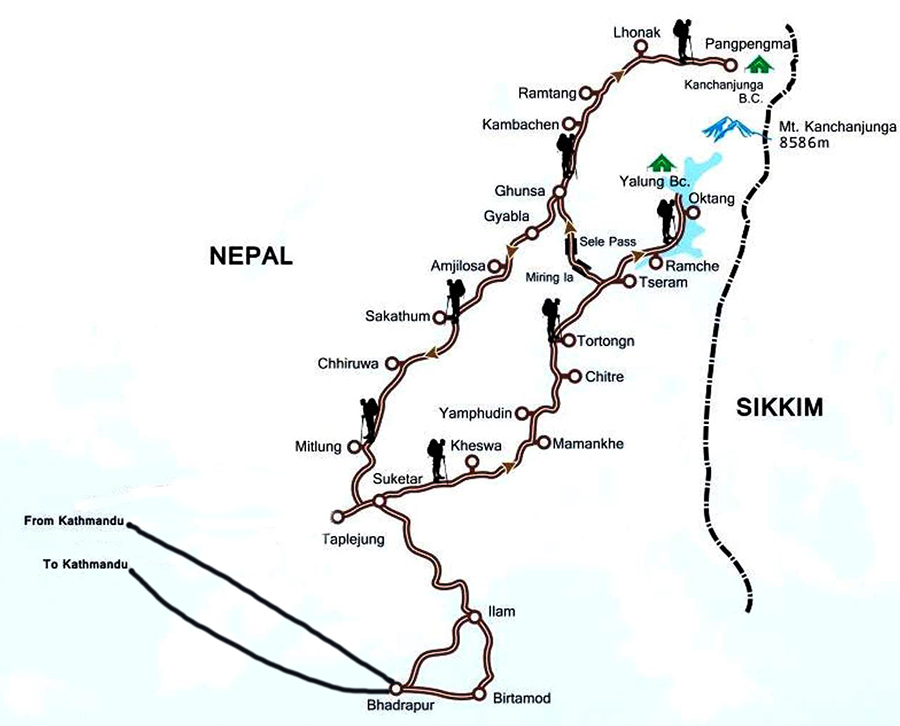Kanchenjunga Trek
Kanchenjunga Base Camp Trek takes you to the base camp of the third-highest mountain in the world, Mount Kanchenjunga. This trek offers stunning views of snow-capped peaks, lush forests, and scenic landscapes. The Kanchenjunga Base Camp trek usually takes around 23 days and covers a distance of about 130 kilometers. The trek starts from Suketar and passes through several small villages like Mitlung, Ghunsa, and Kambachen. The trek is considered to be a challenging one, as it involves steep ascents and descents, as well as crossing several high-altitude passes.
The trek is located in the eastern part of Nepal, and it takes you through beautiful landscapes, diverse culture and remote mountain villages. Therefore, it is recommended that trekkers have prior experience in high-altitude trekking and are in good physical condition. Overall, the Kanchenjunga Base Camp Trek is a rewarding experience that offers breathtaking views of the Himalayas and a chance to immerse you in the rich culture and natural beauty of Nepal. The trek offers stunning views of the mountain peaks, remote villages, and diverse flora and fauna.
Trip Highlights
- Offers stunning views of snow-capped peaks, lush forests, and scenic landscapes
- Passes through several small villages like Mitlung, Ghunsa, and Kambachen
- Takes through the Kanchenjunga conservation area, which is home to a diverse range of flora and fauna
- Trek offers stunning views of the mountain peaks, remote villages, and diverse flora and fauna
- Involves steep ascents and descents, as well as crossing several high-altitude passes
How high is the Kanchenjunga Base Camp trek?
The Kanchenjunga Base Camp trek is a challenging trek in the Himalayan region of Nepal. The highest of the Kanchenjunga Base Camp trek varies depending on the route taken, but the base camp itself is located at an altitude of around 5143 meters (16,873 feet) above sea level. However, it is important to note that the trek involves a lot of uphill and downhill walking, and the altitude can increase significantly as you climb higher up the mountain. It is essential to acclimatize properly and be prepared for the high altitude before embarking on this trek.
Kanchenjunga Base Camp Trek difficult
The trek is considered a challenging trek that requires a good level of fitness and experience in high-altitude trekking. The trek takes you through rugged terrain and steep ascents and descents and reaches elevations of up to 5388 meters (17,673 feet).
The trek can be physically demanding and requires several days of continuous walking at a high altitude. Trekkers will need to acclimatize to the altitude to avoid altitude sickness and be prepared for potential changes in weather conditions and sudden changes in temperature.
In addition to the physical demands, the trek also involves camping and carrying all necessary equipment and supplies, adding to the overall challenge of the trek. Therefore, it is recommended that trekkers have previous trekking experience and a good level of fitness before attempting the Kanchenjunga Base Camp Trek. It is also advisable to undertake the trek with a licensed guide or trekking agency for safety reasons.
Kanchenjunga Base Camp Trek Permit
The trek takes you to the base camp of the world’s third-highest mountain, Kanchenjunga. If you want to trek to the Kanchenjunga Base Camp, you will need to obtain a trekking permit.
To obtain a permit for the Kanchenjunga Base Camp Trek, you need to have at least two trekkers in your group and hired a licensed guide. You can obtain the permit from the Nepal Tourism Board or a local trekking agency.
The permit fee for this trek is as follows:
- USD 20 per person per week for the first four weeks and USD 25 per person per week after four weeks
In addition to the trekking permit, you will also need to obtain a restricted area permit, as the Kanchenjunga region is a restricted area. The permit fees for the restricted area permit are as follows:
- USD 10 per person per week for the first four weeks
- USD 20 per person per week after four weeks
It is also essential to have the necessary documents, such as a valid passport and a trekking insurance policy, before applying for the permit. It is recommended that you obtain your permits from a reputable trekking agency, as they can provide you with up-to-date information and help you obtain the necessary permit.
Details Itinerary
Day 01: Arrive in Kathmandu Valley
The team of Blue Sheep Trek will be there for you to pick up and welcome you. From the airport, you will take you through Thamel and you will take some rest at the hotel. At the hotel, there will be a guide with a brief description of the trek.
Day 02: Sightseeing in Kathmandu
Kathmandu is a fantastic destination for sightseeing, with its rich cultural heritage and beautiful landscapes. Today, we will spend who day in the Kathmandu Valley. This day is not only for exploring Kathmandu but also to prepare for the special trekking permit. It is because the Kanchenjunga Base Camp trek is a restricted trekking area where we need a special trekking permit.
Day 03: Fly to Bhadrapur and Drive to Taplejung (7 to 8hrs)
Very early in the morning, we will fly toward Bhadrapur. To reach Bhadrapur, it takes almost 45 minutes from Kathmandu Valley. Bhadrapur is a small village which is located in the southeastern part of Nepal. From Bhadrapur, we will take a local jeep or bus to drive toward Taplejung. We will follow or head east on the Mechi Highway and from Bhadrapur, it takes almost 7 to 8 hours to reach Taplejung.
Day 04: Taplejung to Mitlung (921m / 6 to 7hrs)
Start early in the morning from Taplejung, which is a small town located in the northeastern part of Nepal. The trail is a gradual uphill climb through a forest of rhododendron, bamboo, and pine. After a few hours of hiking, you will reach a small village called Sinwa. Along the way, you will pass through several small streams, and waterfalls and finally reach Mitlung.
Day 05: Mitlung to Chiruwa (1,270m / 5 to 6hrs)
The trail is mostly flat, with a few ups and downs, and offers stunning views of the surrounding mountains and valleys. You will also pass by several small villages along the way. After hours of hours trekking, you will reach the villages of Chiruwa, which is located at elevations of around 1300 meters. You can explore the villages, visit the local monastery, or simply relax and enjoy the beautiful scenery.
Day 06: Chiruwa to Sekathum (1,570m / 4 to 5hrs)
Along the way toward Sekathum, you will cross several streams and waterfalls, and pass through traditional Nepalese villages. The trail from Chiruwa to Sekathum follows the Tamor Rivers and passes through dense forests, steep ridges, and small villages. You will also cross several suspension bridges along the way and the trail offers stunning views of the Himalayas.
Day 07: Sekathum to Amjilosa (2,308m / 5 to 6hrs)
To begin the trek, you can start from Sekathum and follow the trail toward the north. After a short while, you will cross suspension bridges over the Sisne River and continue ascent through the forest. The trail passes through several small settlements, including the villages of Toson Kharka, before reaching the beautiful village of Amjilosa.
Day 08: Amjilosa to Gyabla (2,730m / 6 to 7 hrs)
The route passes through dense forests, steep hills, and rocky terrain. The trail also offers spectacular views of the surrounding mountains and landscapes. The village is surrounded by stunning mountain peaks and is a great place to take a break and enjoy the scenery. From Amjilosa, the trail passes through a dense forest of bamboo and rhododendron and you will also pass by several small waterfalls along the way.
Day 09: Gyabla to Ghunsa (3,595m / 4 to 5hrs)
As you approach Ghunsa, the trail becomes more rugged and rocky, but the stunning views of the Himalayas. With a steep climb through a dense forest of rhododendron and pine trees and you will be able to enjoy beautiful views of the surrounding hills and valleys. As you continue along the trail, you will come across several small streams and waterfalls. You will follow the Ghunsa River and hike through stunning landscapes of rhododendron and pine forest.
Day 10: Rest day at Ghunsa
Today, on the rest day at Ghunsa, take a walk around Ghunsa and explore its narrow alleys, traditional houses, and monasteries. A rest day at Ghunsa is a great way to break up your trek and enjoy the beauty of the Himalayas. Just remember to stay hydrated, get enough rest, and be prepared for the next day’s trek.
Day 11: Ghunsa to Kambachen (4,050m / 5 to 6hrs)
From Ghunsa, the trails head northwards through a dense forest of rhododendron, oak, and bamboo, following the Ghunsa Khola River. The trail passes through several small villages and settlements before reaching Kambachen. Along the way, you will pass through several suspension bridges, waterfalls, and steep ascents and descents.
Day 12: Kambachen to Lhonak (4,790m / 4hrs)
Starting from Kambachen, you will ascend toward the Lhonak Glacier. The glacier is a massive river of ice that flows from the Kanchenjunga massif. The trek takes you through beautiful mountain scenery, high-altitude terrain, and diverse flora and fauna. Today will be an incredible adventure that offers stunning scenery and a chance to experience the culture and hospitality of the local people.
Day 13: Trek to Pangpema (5,065m), visit Kanchenjunga Base Camp (5,143m), and back to Lhonak (4,790m / 8 to 9hrs)
From Lhonak, you will trek toward Pangpema. Along the way, you will enjoy stunning views of the surrounding mountains, including Jannu, Yalung Kang, and Kambachen. After reaching Pangpema, we will hike up Kanchenjunga Base Camp Trek. From the base camp, you will have a stunning view of the third-highest mountain Mt Kanchenjunga. After hiking up the Kanchenjunga base camp, we will back to Lhonak. The trek is mostly downhill, and you will pass through several small villages and forests before reaching Lhonak.
Day 14: Lhonak to Ghunsa (3595m / 7hrs)
The trek is mostly downhill, and you’ll retrace your steps through the rhododendron forests and small villages you passed through on the way up. The trail follows the Ghunsa River downstream, passing through dense forests and several small settlements before reaching Ghunsa.
Day 15: Ghunsa to Sele La (4,290m / 5hrs)
To reach Sele La from Ghunsa, trekkers typically break the journey up. Along the way, trekkers will pass through dense forest of rhododendron, and pine, cross rivers and streams, and encounters local communities that practice traditional lifestyle. You will also cross several suspension bridges over rivers and streams and trek through high-altitude terrain.
Day 16: Sele La to Tseram (3,870m / 8hrs)
The trail involves a steep climb up to the top of the Sele La Pass. From the top of Sele La pass, trekkers can enjoy breathtaking views of the surrounding mountains including Makalu and Kanchenjunga. After crossing Sele La Pass, the trail descends through lush forests and pastures before reaching the villages of Tseram. Tseram is a small village that offers a stunning view of the surrounding mountains.
Day 17: Tseram to Ramche (4,580m) and back to Tseram (3,870m / 8hrs)
The trails begin with a steep climb from Tseram to Yalung Base Camp which takes around 2 to 3 hours. The trail follows the Simbuwa Khola River and passes through a dense forest of alpine meadows. From Yalung Base Camp, the trail continues to climb up to Ramche. The trail offers stunning views of the towering peaks of Kanchenjunga and its surrounding valleys. From Ramche, we will trek back to Tseram.
Day 18: Tseram to Tortong (2,995m / 5hrs)
The trial is mostly downhill and passes through a beautiful forest of rhododendron, pine, and bamboo. You will also pass by the Simbuwa Khola River which adds to the natural beauty of the trek. Along the way, the trek is a beautiful and rewarding experience, offering stunning views of the Himalayan Mountains and the surrounding landscapes.
Day 19: Tortong to Yamphudin (2,080m / 8hrs)
With a steep climb through the dense forest of rhododendron and oak trees, and it gradually opens up to the meadows and pastures of the high hills. Along the way, you will also come across several traditional villages inhabitant by the Limbu people, who are indigenous inhabitants of this region. As you approach Yamphudin, the trail descends through the lush forest of bamboo and ferns, and you will reach finally the villages of Yamphudin.
Day 20: Yamphudin to Khebang (1,910m / 4hrs)
Follow the trail that leads to the west from Yamphudin and you will pass through several small villages and settlements. After walking for around 4 to 5 hours, you will reach the villages of Khebang. The trail is moderately difficult, and it can be taking longer depending on your pace. The village of Khebang is located on the bank of the Tamor River and is surrounded by beautiful hills and forests.
Day 21: Khebang to Thorpu (1,500m / 9hrs)
From Khebang, we will trek toward Thorpu. Follow the trail that passes through beautiful forests, remote villages, and high mountain passes. Along the way, you will encounter stunning views of snow-capped mountains, waterfalls, and glaciers. The trail is also rich in flora and fauna, and you may spot Himalayan Thar, musk deer, and snow leopard if you are lucky.
Day 22: Drive to Bhadrapur
Today, we will drive toward Bhadrapur from Thorpu. Starting from Thorpu, we will head south on the Kanchenjunga Base Camp trek route towards Taplejung. Continue on this route until you reach the town of Taplejung. From Taplejung, take the Mechi Highway and continue towards Bhadrapur. You will pass through several towns and villages, including Dobhan, Hilihang, and Phidim, before reaching Bhadrapur.
Day 23: Fly back to Kathmandu
About 45 minutes flight from Bhadrapur, we will reach Kathmandu valley. From the domestic airport, you will take to your hotel and take some rest. If you want to explore the Kathmandu valley then you can take a taxi and explore all over the Kathmandu valley.
Day 24: Final departure
Our team and the guide who is with you on your trekking journey will be at the international airport to see you off. We will say our goodbye and hope that you will give us an opportunity to trek with you all over Nepal.
Manual Note :
Trip Reviews

Name: John
JohnAnnapurna Base Camp Trek with Sukman
“The Annapurna Base Camp trek was one of the most beautiful experiences of my life. The scenery was breathtaking and the people were incredibly friendly. It was a challenging trek, but well worth the effort.”

Name: Sarah
CanadaABC trek with Bluesheep trek
“I absolutely loved the Annapurna Base Camp trek. The scenery was incredible, from lush forests to towering snow-capped peaks. The highlight was definitely reaching base camp and seeing Annapurna South up close.”

Name: Mike
AustraliaAnnapurna Trek with Sukman
“The Annapurna Base Camp trek was an amazing experience. The trail was well-maintained and easy to follow, and the tea houses along the way were cozy and welcoming. The view from base camp was unbelievable – I felt like I was on top of the world!”

Name: Cecelia Muller
USAAnnapurna Circuit, March 2023
I did the Annapurna Circuit this past March and it’s probably the best thing I have done and will ever do in my life. Don’t get me wrong, it was definitely challenging – as someone who loves her hot showers – but Sukman made the whole process such a breeze. He found our group teahouses and called ahead of time to reserve our slots. He also made sure we went at a reasonable pace and doled out lunch and tea breaks as the group needed it. At higher elevations, he was even more careful to pay attention to the elevation we gained each day and each person’s symptoms (or more hopefully, lack thereof) to avoid altitude sickness.

Name: Patrick Wasil
USAAnnapurna Circuit Trek
I hiked the Annapurna Circuit in March 2023. Sukman went above and beyond to make sure that everything went smoothly. The hike itself certainly was challenging, but Sukman made it as easy as possible. He has extensive knowledge of the trail, towns, and tea houses along the way. He called ahead to reserve rooms for us in the best tea houses because they can get crowded depending on the season. He curated tea and meal breaks as well. I particularly liked how closely he monitored the health and status of everyone in our group keeping an eye out for any symptoms of altitude sickness and adjusting the hike accordingly. Overall, Sukman was a fantastic guide on the Annapurna Circuit Trek and I will definitely utilize his services again on my next trip to Nepal!

Name: Uli
GermanyUpper Mustang
I trekked with Shukman from Blue Sheep Trek for 10 days in Upper Mustang. Shukman is a very nice guide. He has a good feeling what his customers need. I recommend trekking with Blue Sheep Trek. Upper Mustang is a incredible beautiful place. Thank you Shukman!

Name: Anouk
We’ve had a lovely time in the Kanchenjunga area! The trek was beautiful and challenging, but our guide Sukman made sure that everything was fixed and taken care of, so we could enjoy every moment of it!


